Would you like to take a panorama tour China from Beijing? This 18-day itinerary will satisfy all your China fantasies. Why start a China trip from Beijing? Beijing is the capital of China and is one of the most accessible cities in China. So you will get many options for your international flights. Traveling from Beijing to Xi’an, you will have deep knowledge of China’s history. Beijing is home to the Forbidden City, the Temple of Heaven and the best-preserved part of the Great Wall, and all of these witnessed the history of Ming and Qing Dynasties(1368-1912). And Xi’an was the capital of 13 dynasties in ancient China, where you could see a lot of historical sites like the Terracotta Army and the Big Wild Goose Pagoda. Besides, you will also take a close look at giant panda in Chengdu, enjoy the karst landscapes with picturesque river view in Guilin, have a stunning snow mountain view in Lijiang, stroll in the quiet ancient town in Dali, and visit China’s highest building in Shanghai. No matter you are a fan of China’s culture or nature, this itinerary will be your best choice. Don’t hesitate anymore, and put your hand on the “Contact us” button!

Ni Hao! Welcome to Beijing. On arrival, your tour guide will be waiting for you at the arrival hall of the airport. Then you will be transferred to the hotel and check in.
This morning we will first visit Tian’anmen Square. Tian’anmen Square has a history of over five hundred years since it was first built, and the entire square with all buildings expresses a sense of imperial supremacy. Walk through the square, there are a pair of stone lions on each side of the Jinshui River in front of Tian’anmen Square. The stone lions are to exorcise evil spirits for the imperial court. And there are seven Chinese white jade stone bridges over the river.
And then we will enter the Forbidden City (closed each Monday) through the Tian’anmen Gate Tower. The Forbidden City was where 24 emperors lived and ruled the country for more than 500 hundred years in the Ming (1368-1644) and Qing(1636-1912) Dynasties. In 1987, the Forbidden City was inscribed on the World Cultural Heritage List and became the most famous landmarks of Beijing.
After lunch, we will transfer to the Summer Palace. The Summer Palace is a royal garden of China during the Qing Dynasty. It is located in the western suburbs of Beijing, 15 kilometers from the city center, and covers an area of about 2.9 square kilometers. During your visit, you will walk through a 728-meter Long Corridor. This corridor was built to enjoy the garden views no matter on rainy days or snowy days for the emperors and empresses. In 1992, it was recognized as the longest corridor in the world and was listed in the Guinness Book of World Records.
Free Time Idea: If you are still energetic, you can enjoy the glitz and glamour of Beijing at Wangfujing Street this evening. Wangfujing Street, located on the east side of the Forbidden City, is a famous commercial district with a history of over 100 years. Here you can taste almost all Beijing local food, such as pea cake, noodles with soybean paste, Ludagunr (glutinous rice rolls with sweet bean flour), etc.
There is a funny story about the Ludagunr. Ludagunr means rolling donkey in Chinese. It is said that, in the late Qing Dynasty, once Empress Dowager Cixi wanted to try some new food. After the imperial chef racked his brain, he decided to make a new dish with red bean paste wrapped in rice flour. As soon as the new dish was finished, a eunuch named Little Donkey came to the kitchen. He accidentally spilled the new dish into the basin filled with soybean flour. The chef was so angry but there is no more time to cook another dish. So the chef had to present the dish to the Empress Dowager Cixi with anxiety and fear. Surprisingly, Empress Dowager Cixi thought it tasted good. She asked the chef, "What's this called?" The chef thought that it was the Little Donkey’s spilled the dish into soybean floor, so he told Empress Dowager Cixi, "It's called Ludagunr (rolling donkey)." From then on, there was the snack Ludagunr.
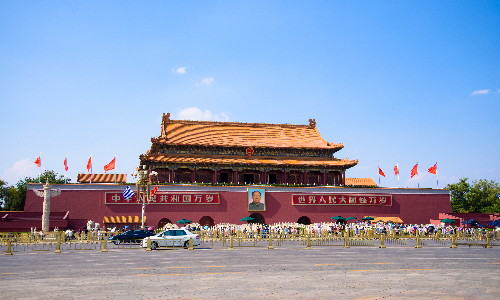
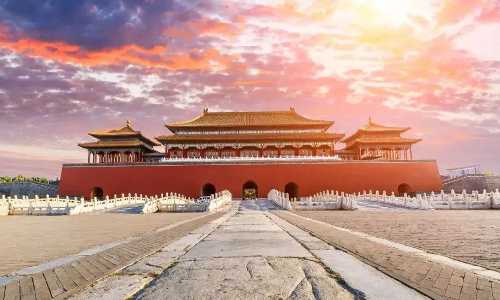
Today we will drive for about 1 hour(50KM) to visit the Sacred Way and Chang Tomb of the Ming Tombs. Ming Tombs is to the north of Beijing downtown. Both the Sacred Way and Chang Tomb are parts of the Ming Tombs. After the Ming Dynasty moved the capital to Beijing, the construction of the Chang Tombs began. This is a large mausoleum complex that took more than 20 years to build. A 1060-meter-long Sacred Way leads from the southern tomb gate to the Chang Mausoleum, flanked by structures such as the Dragon and Phoenix Gate, the Grand Palace Gate, and stone plaques, which symbolize the authority of the emperor and create the majestic atmosphere of the Ming Tombs.
After lunch, we need to drive for one hour to go to Mutianyu Great Wall. The whole distance is about 40 kilometers. Mutianyu Great Wall is to the northeast of the Ming Tombs. The Great Wall is one of the longest ancient defense projects not only in China but also in the world. From the Western Zhou Dynasty (1046BC-771BC) to the Qing Dynasty, the construction of the Great Wall lasted for more than 2,000 years, with a total length of more than 20,000 kilometers. The Mutianyu Great Wall is the best part of the Great Wall. The wall of the Mutianyu Great Wall remains intact, reflecting the ancient lasting appeal of the Great Wall well. The scenic area is equipped with a first-class cable car to ascend the Great Wall. Your Great Wall tour is scheduled in the afternoon because there are fewer tourists in the afternoon.
Optional Dinner: Tonight, reward yourself with an authentic Peking Roast Duck dinner. Roast duck is a world-renowned Beijing dish that originated in China during the North and South Dynasties (420-589). Roast duck was the food of the royal court at that time. It was not until the Ming Dynasty that roast duck became popular among the general public. It is said that Emperor Zhu Yuanzhang, the first emperor in the Ming Dynasty, was so fond of roast duck that there is an unofficial history that says he ate a roast duck every day.
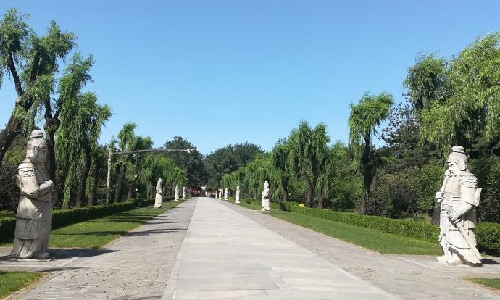
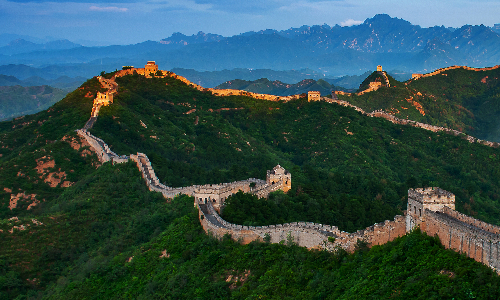
 Xi’an
Xi’an In the morning, we will first visit the Temple of Heaven. The Temple of heaven is 600 years old. This is the main place for the emperors in the Ming and Qing dynasties to worship heaven and pray for a good harvest. The ancient emperors attached great importance to the worship ceremony. Three days before the ritual, the emperor had to start fasting. Two days before, the blessing words to be read at the ritual needed to be written. The day before, animals were to be slaughtered as offerings. The emperor hoped that his devotional prayers would reach heaven and give the people a good harvest.
Next, we will visit Old Beijing Hutong. Hutongs are lots of small alleys locate in the city centre of Beijing. Hutongs emerged in the Yuan Dynasty (1271-1368) and have a history of more than 700 years. Take a rickshaw ride around the hutongs and talk to the old residents, and you’ll find that there are different stories in different hutongs.
After lunch, you will be transferred to the airport and take the estimated flight CZ6948 17:45/20:00 to Xi’an. On arrival in Xi’an, your tour guide will take you to the hotel directly. After check-in, you could enjoy the free evening.
Xi'an, known as Chang'an in ancient times, is the capital of Shaanxi Province. Xi'an, Cairo, Athens and Rome are known as the four ancient capitals of civilization in the world. It used to be the capital of more than 10 dynasties. Xi'an has a resident population of about 10.2 million and equipped with one international airport and three railway stations. There are direct flights or trains from Xi’an to other major cities in China.
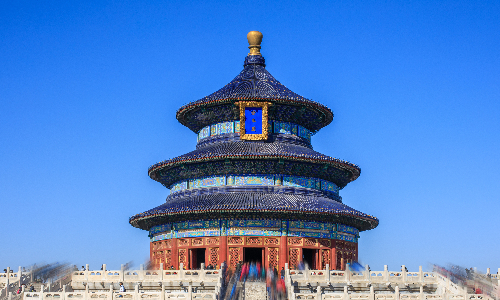
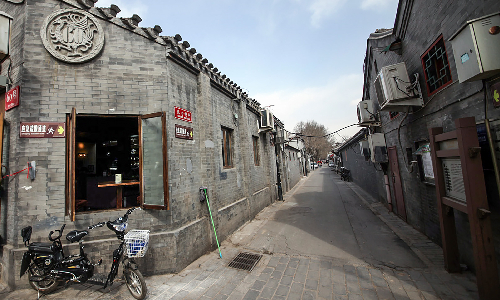
Today we will drive for about 1 hour(45KM) to visit the Terracotta Warriors and Horses Museum. It is in the northeast of Xi'an city. The Terracotta Warriors and Horses is the largest underground military museum in the world as well as one of the greatest discoveries in the history of world archaeology. The terracotta warriors are particularly realistic, so that when they were first excavated, archaeologists suspected that they were fired with real people. There are more than 7000 terracotta warriors that have been excavated, and all of them have different faces. And the bronze chariots and horses in the museum are the most complete, highest-grade, and best-made bronze artifacts that have been excavated, and are the largest bronze artifacts ever discovered in the world.
Next, we will visit Big Wild Goose Pagoda. The Big Wild Goose Pagoda, with a history of more than 1,300 years, has become a distinctive symbol of the ancient city of Xi’an. The pagoda was built to store the Buddhist scriptures brought from ancient India by Master Xuan Zang. According to legend, when Master Xuan Zang was on his way to seek Buddhist scriptures, one day he encountered a gale after walking in the desert and lost his way. With little food and water left, he was about to fall into a desperate situation. But Master Xuan Zang still stayed calm and chanted sutras. At that time, a big wild goose flew near and led Master Xuan Zang out of the desert. So Master Xuan Zang was grateful to the wild goose. After returning, when he built the pagoda, he named it "Wild Goose Pagoda". There is another smaller pagoda in Xi’an, so this one was renamed Big Wild Goose Pagoda later.
After that, we will visit the City Wall. The Xi’an City Wall is the best-preserved ancient city wall in China. The wall was built on the foundation of Chang’an City, the Imperial City in the Tang Dynasty (618-907). The wall is 12 meters high and 12-14 meters wide at the top. Standing on the wall, you can enjoy the view of the whole ancient city. Besides walking and enjoying the view, you can also rent a bicycle and ride on the wall. There are single-ride bikes, double-ride bikes and triple-ride bikes, and you could choose what you need.
Free Time Suggestion: In the evening, you could visit Great Tang All Day Mall by yourself. Located at the foot of the Big Wild Goose Pagoda, the Great Tang All Day Mall is a pedestrian street built with the background of the prosperous Tang Dynasty. Walking on the pedestrian street, you will feel that you have traveled to the Tang Dynasty. Here you will see a beautiful girl in Tang costumes playing the Chinese Zheng. Walk forward, you can also see many statues of historical figures from the Tang Dynasty. The flourishing Tang culture is on full display here.
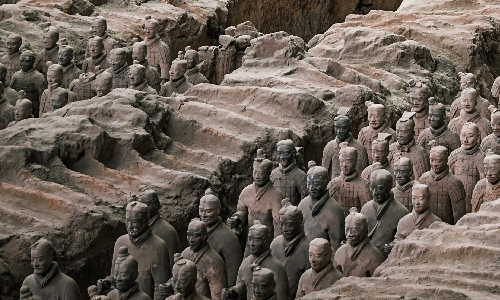
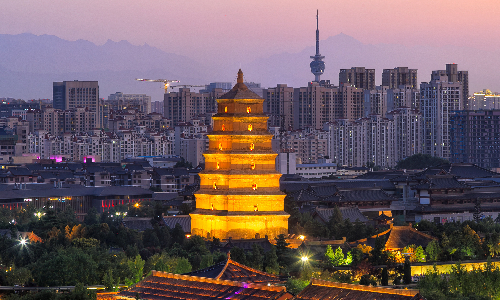
In the morning, we will visit Shaanxi History Museum (closed each Monday). The appearance of the Shaanxi History Museum building is dominated by the Tang Dynasty style. Xi’an used to be the capital of 13 dynasties throughout history with a wealth of valuable relics. Among all the exhibits in the museum, I want to introduce one of them that impressed me most, the Colored Wild Goose and Wild Goose shaped Bronze Lamp. The lamp is a relic of the Western Han Dynasty(202 BC-8 AD), excavated in 1985 from the Western Han Tomb in Dianta Village, Shenmu County, Shaanxi Province. The lamp is 54 cm in height, 33 cm in length and 17 cm in width. At that time, the lamps were all ghee lamps. This bronze lamp was carefully designed to be much less oily while burning than ordinary lamps, and is a masterpiece among Han Dynasty lamps. The technology and craft amazed me a lot.
Then you will visit a local family in Xi’an. This is a good opportunity to experience daily life with a local family. By learning how to make dumplings, you will have the opportunity to learn about the Chinese way of living and eating, and to get to know the city and its people better.
In the afternoon, we will go to the Great Mosque. With a history of more than 1300 years, the mosque was founded in 742 in the Tang Dynasty. The total area of the temple is 13,000 square meters, and the construction area is about 6,000 square meters. It was the only mosque that was built in traditional Han Chinese style. Inside the mosque, you will admire exquisite old buildings as well as the calligraphy work on the stone tablets.
Then you will have some free time to stroll at the Muslim’s Quarter. When it comes to Xi’an cuisine, the first place that comes to mind is the Muslim’s Quarter. It is famous for its variety of delicious snacks and is loved by many visitors from all over the world. Here you can taste almost all Xi’an authentic snacks, such as Roujiamo(marinated meat in a baked bun), Qiancengbing(multi-layer baked pastry), Biangbiang Noodle, etc.
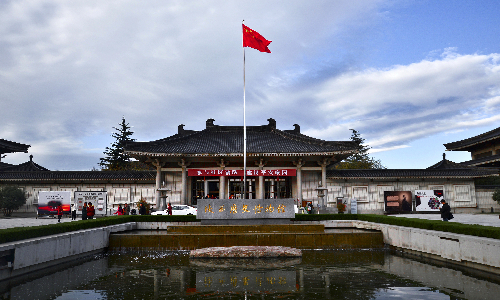
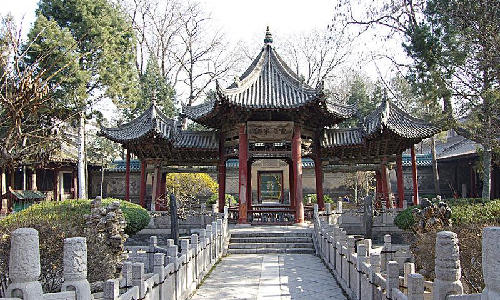
 Chengdu
Chengdu Today you will take the estimated train D1923 10:03/13:59 to Chengdu. After arriving in Chengdu, you will be transferred to the hotel and check-in.
Chengdu, also known as Jincheng, is the capital of Sichuan Province, with a total area of 14,335 square kilometers and a resident population of 16,581,000. Sichuan is famous for its Sichuan cuisine, and the most authentic Sichuan dishes are found in Chengdu. Sichuan cuisine is one of the four major cuisines in China, with spicy as its most distinctive feature. UNESCO has awarded Chengdu the title of “World Capital of Gastronomy”.
After arrival, you will go to visit the Wuhou Shrine Museum. The Wuhou Shrine Museum is a temple dedicated to Liu Bei, Zhuge Liang and other heroic figures of the Three Kingdoms period(220-280). Liu Bei was the emperor of the Shu Kingdom(221-263) and Zhuge Liang was the most excellent Prime Minister at that time. Zhuge Liang was an outstanding politician, general, writer and inventor in ancient China. Now, people still worship him as a god-like being.
Then you will have some free time at Jinli Street. Legend has it that Jinli was once one of the oldest and most prosperous commercial streets in the history of the west part of Sichuan Province, famous throughout the country as early as the Qin and Han dynasties(221BC-220AD). Here you can savor all the Sichuan authentic snacks, such as Saniaoniuwan (juicy beef ball), Tangyouguozi (sweetened fried rice cake), Boboji (spicy soused chicken), etc.
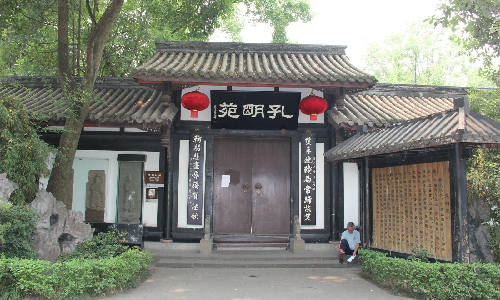
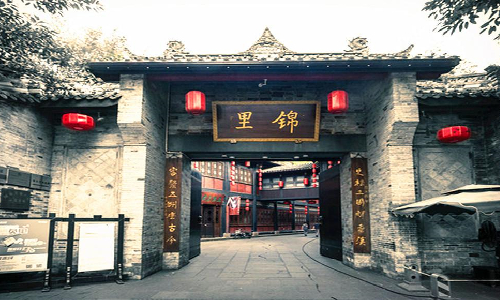
This morning your tour guide will take you to visit the Chengdu Research Base of Giant Panda Breeding, which is located about 10 km from the city center. The giant panda is the most adorable creature on earth. No matter you are traveling with your children, your lover, or your friends, a panda visit will round off your China tour. The Chengdu Research Base of Giant Panda Breeding owns hundreds of giant pandas, including the adult panda and newborn panda. In order to simulate the living environment of the giant pandas in the wild, there are lakes, streams, bamboo forests, lawns, and so on. Here visitors can observe the living conditions of giant pandas in proximity.
Then we will visit Du Fu Thatched Cottage which was Du Fu’s former residence in Chengdu. Du Fu was a great poet of the Tang Dynasty, and a total of about 1,500 of Du Fu's poems have been preserved. He lived in this place for nearly four years and composed hundreds of poems. So Du Fu Thatched Cottage is considered a “holy place” in Chinese literature.
After that, we will visit People’s Park. People’s Park is the main place for local people to escape from the bustle and hustle of the city. The most famous in the park is the Heming Tea House, which has a history of more than one hundred years. With bamboo chairs, small tables, a cup of the best-scented tea, it attracts lots of locals to enjoy the leisurely afternoon every day.
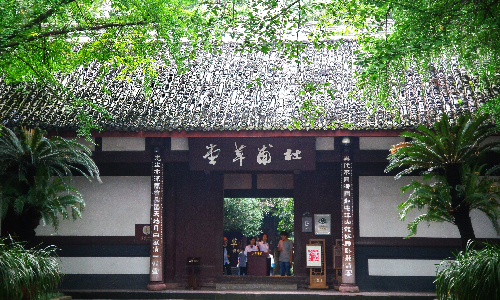
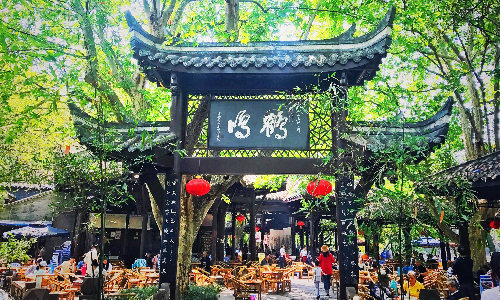
 Guilin
Guilin After you check out, your guide will take you to the airport to take the estimated flight SC4764 11:45/13:00 to Guilin. The Guilin guide will meet you at the arrival hall and take you to your hotel. You will have a free afternoon after check-in.
 Longsheng
Longsheng Today we will go to Longsheng County to see the rice terrace. It may take around 80 minutes. The whole distance is about 80 kilometers. Longsheng County is to the north of Guilin City. After arriving at Longji Rice Terraces, we will take a sightseeing bus to Ping’an Village. Ping’an Village is a place to experience the folk customs of the Zhuang people. It was built at the end of the Qing Dynasty and the beginning of the Republic of China, and is the core village for sightseeing in Longji Scenic Area. The Zhuang people live together and retain their distinctive Zhuang costumes and simple living customs. After lunch, we will continue to explore the terraced fields. You will see the “Seven Stars Around the Moon” and the “Nine Dragons Five Tigers” which are the essence of the Longji Terrace. Seven Stars Around the Moon is composed of seven small hilltop terraces and a large half-moon-shaped hilltop terrace. Nine Dragons Five Tigers are huge mountain ridges, like the back of a dragon. The five tigers are five hills around the dragon. After the visit, we will drive back to Guilin.
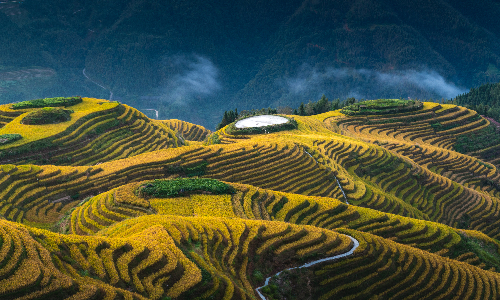
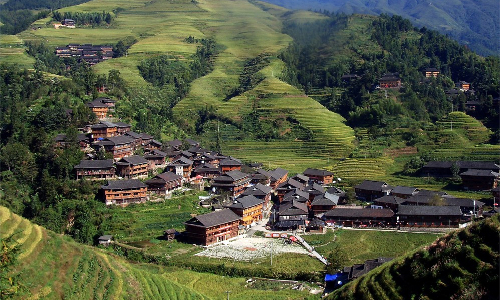
 Yangshuo
Yangshuo Guilin
Guilin In the morning, we will take the Li River Cruise to Yangshuo. The 83-km long Li River from Guilin to Yangshuo is the essence of the whole Li River. It is a typical area of karst terrain, which concentrates the essence of Guilin’s natural views. The beautiful scenery here gives people the feeling of “wandering in landscape paintings”. On the Li River Cruise, you can leisurely enjoy the picturesque scenery of the Li River for about 4 hours. Along the Li River, there are fishermen rowing bamboo rafts for fishing and villagers carrying their purchased household goods up the mountain. You will have lunch on board.
In the afternoon, the cruise will stop at the pier of Yangshuo. Then we will visit Yangshuo West Street. West Street is the oldest street in Yangshuo, with a history of over 1400 years. It is the most densely populated street by foreigners in China, with three times as many foreigners living here each year as the Chinese resident population. The restaurants, bars and stores on West Street are a mixture of Chinese and Western styles. In the evening, we will drive back to Guilin. It needs to drive for about 90 minutes(70KM).
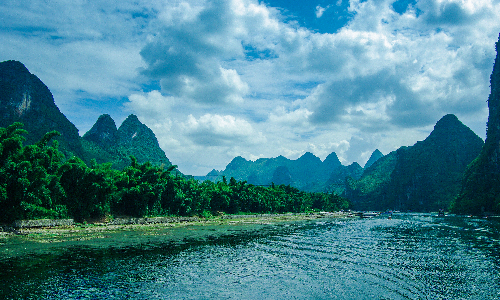
 Lijiang
Lijiang Today you will take the estimated flight MF8635 10:45/12:40 to Lijiang. Upon arrival in Lijiang, your guide will welcome and meet you at the arrival hall and then take you to the hotel. You are free to spend the afternoon.
This morning your tour guide will meet you at your hotel. We will first visit the Jade Dragon Snow Mountain. Jade Dragon Snow Mountain is the southernmost snow mountain in the northern hemisphere. It is a sacred mountain in the mind of all minority ethnic groups in Lijiang. The Jade Dragon Snow Mountain is fascinating with its charming landscape, mysterious legends, and unconquered peak. You could take some pictures at the Spruce Meadow. Spruce Meadow is a huge lawn hidden in the primeval spruce forest at an altitude of 3,240 meters, and it is located on the east foot of Jade Dragon Snow Mountain. Spruce Meadow is the place where the first Naxi (an ethnic minority in China) lovers died for love. According to legend, the two lovers were Kaimei and Yu Le Pai. Their sweet love life was destroyed by the feudal polygamous marriage. The father of the boy forced him to married another girl. They longed for the pure love that belongs only to them, so they both went to the Spruce Meadow and suicided for love. Whenever the torch festival is held in June, young men and women near Jade Dragon Snow Mountain will make paper figures of Kaimei and Yu Le Pai and come to Spruce Meadow to pay tribute to their loyalty to love.
In the afternoon, we will visit the Lijiang Ancient Town. The ancient town was built in the late 13th century. It is in the center of Lijiang City. During your visit inside the town, you will see a giant waterwheel. The waterwheel, also known as Kong Ming Wheel, is the oldest agricultural irrigation tool in China, and is a precious historical and cultural heritage of our ancestors who created superb labor skills. It is said that a craftsman named Hua Lan made the prototype of the waterwheel in the Han Dynasty. Then it was perfected in the Three Kingdoms Period and popularized in the Shu Kingdom. Moreover, there are also other attractions worth visiting in the ancient town, such as Sifang Street, Mu Fu Mansion, Wufeng Tower, etc.
Authentic Snack in Lijiang: The most famous and popular local snack in Lijiang is Lijiang baba. The main raw material is the fine wheat flour produced in Lijiang, which is kneaded into a dough by adding the spring water flowing down from the Jade Dragon Snow Mountain. Then the dough is rolled into a thin piece, sprinkled with minced ham or sugar and rolled into a cylinder. The two ends of the cylinder need to be pressed. Finally, it is fried in a pan until turns golden. There are two flavors of Lijiang baba, salty and sweet, which can be chosen according to your taste.
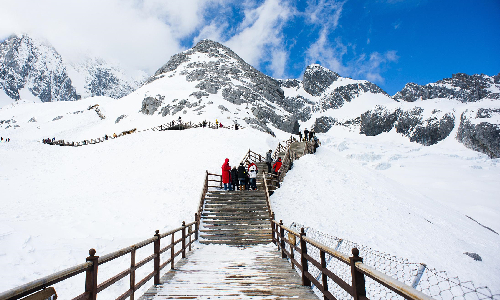
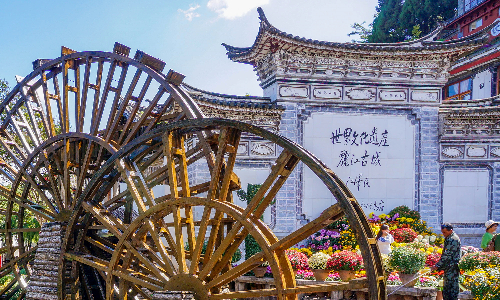
 Jianchuan
Jianchuan Today we will transfer to Jianchuan County, where Shaxi Ancient Town and Shibao Mountain are located. The whole trip needs to drive for about 100 minutes. Jianchuan County is about 100 kilometers southwest of Lijiang. Upon arrival, you will visit Shibao Mountain. On the mountain, there are 17 finely carved, vivid, and unique grottoes. Among them, there is a cave with the statues of the Buddhist Tantric deities, which the Bai people believe in. And the believers always pray for pregnancy, wealth, safety, and so on.
In the afternoon, we will visit the Shaxi Ancient Town. Located between Dali City and Lijiang City, Shaxi is a small town with a long history and is surrounded by green hills. Shaxi Ancient Town was once a land dock on the Yunnan-Tibet Tea Horse Road, an important traffic hinge to Tibet. Although the ancient road has gone, the rustic atmosphere of the ancient Tea Horse Road is left behind. Compared to the ancient town of Lijiang and ancient town of Dali, Shaxi ancient town is more like an escape from the hustle and bustle of the big cities. You will be impressed by the preciousness of the original appearance of Shaxi Ancient Town.
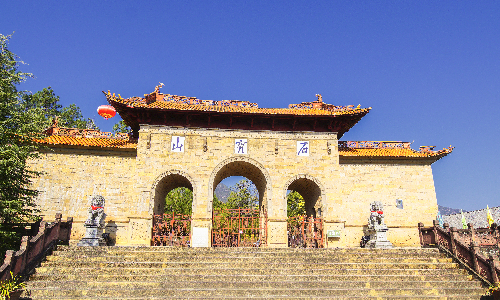
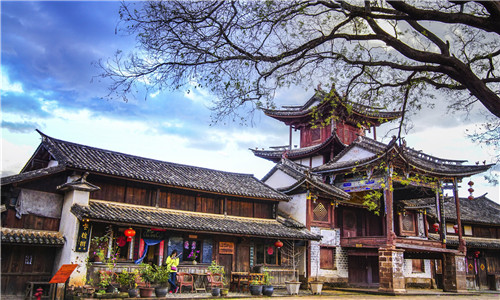
 Dali
Dali Today we will transfer to Dali. The whole distance from Shaxi to Dali is about 150 kilometers. It needs to drive for about 2 hours. Dali is to the south of Shaxi Ancient Town. After arrival in Dali, we will first visit Erhai Lake. Erhai Lake is located next to the ancient city of Dali. You will have a boat ride on the lake. During your boat tour, you will see the mountains near the lake, named Cangshan Mountains. Legend has it that there is a princess who was just married, and her husband went off to a war a couple of days after the wedding. The husband was gone for more than ten years and did not return. The people who came back from the war said he had died. The princess began to cry day and night, and eventually, tears became Erhai Lake. At this time, the princess was dying, coinciding with the return of her husband. Seeing that the princess was dying, her husband was inconsolable and vowed that he would transform to the mountains to guard Erhai Lake. Thus, there was Erhai and Cangshan Mountains.
In the afternoon, we will visit the Three Pagodas at Chongsheng Temple. The Three Pagodas was built in the Tang Dynasty, and is one of the oldest and most majestic buildings in southern China. The tallest of the three pagodas is the Qianxun Pagoda, which is 69.13 meters high, and the smaller pagodas on either side are 42.17 meters high. The bricks of the three pagodas are covered with various Sanskrit and Chinese mantras of the Buddhist, which provide valuable proof for the study of religion in ancient times.
Afterward, we will visit the Dali Ancient Town. The Dali Ancient Town was founded in the Tang Dynasty. It has been the political, economic, and cultural center of Yunnan for more than 500 years during the Tang and Song dynasties. Here you can taste the most authentic Dali cuisines, such as Casserole Fish. The fish in this dish are all bowfin or carp fished from the Erhai Lake. Cooked in a casserole with tofu, shiitake mushrooms, trepang and many other fresh ingredients, this dish has become one of the most popular dishes in Dali.
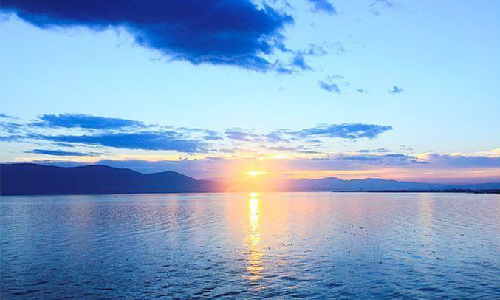
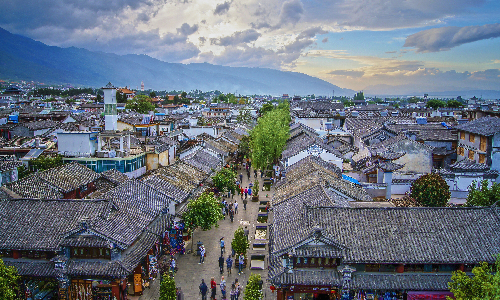
 Shanghai
Shanghai Today you could enjoy a free morning. Then your guide will take you to the airport and you will take the estimated flight MU9717 12:15/15:45 to Shanghai. After arriving in Shanghai, your Shanghai guide will take you to the hotel and help you to check-in.
Free Time Suggestion:
Tonight, you could visit Tianzifang Market by yourself. Tianzifang Market is named after an ancient painter, Tian Zifang. Tianzifang is based in an old alleyway area in Shanghai. In addition to some galleries and art stores, many Shanghai locals still live in the area.
Today we will first visit Yu Garden (closed each Monday). The Yu Garden, known as the “Garden of the City”, is a famous classical garden in the south of the Yangtze River in Shanghai, with a history of more than 400 years. It was a private garden built by an official with a high rank in the Ming Dynasty, Pan Yunduan. His position at the time was equivalent to the current position of Procurator General of the Supreme People's Procuratorate of the People's Republic of China.
Then you will visit the Jade Buddha Temple, and it was built in 1882. The main attractions in the temple were two jade Buddha statues, and that’s why the temple was so named. The two jade Buddha statues respectively are a sitting Buddha and a reclining Buddha. They were brought from Burma by a Buddhist master, Hui Gen. Master Hui Gen followed the example of Master Xuan Zang of the Tang Dynasty and traveled west to obtain Buddhist scriptures. When he passed by Burma, he found five pieces of beautiful jade, so he carved them into Buddha statues and brought them back to China. When he passed through Shanghai, the Buddhists there sincerely begged him to leave behind two Buddha statues, and that’s the two jade Buddha statues we can see now.
After lunch, you will go to see the Bund. The Bund is one of Shanghai’s most famous and must-see attractions. The Bund was once the concession area and now became the most prosperous place in Shanghai. Your guide will take you to see one or two old buildings on the Bund, which were built hundreds of years ago.
Then we will visit the bustling shopping street-Nanjing Road. The Nanjing Road is a blend of old-fashioned tradition and avant-garde fashion, and is known for its long history, gorgeous architecture, and splendid night view. Here you can taste the most popular food in Shanghai for the Mid-Autumn Festival every year, pork mooncakes. The pork mooncakes at the Laodafang Restaurant are the best in the minds of Shanghai locals. Every Mid-Autumn Festival, the queue for mooncakes here is never shorter than 50 meters. People will come here as early as 7 am and wait for the restaurant to open. If there's not a lot of people lined up here when you pass by, then buy a pork mooncake and try it! The pork mooncake is covered with a crispy and thin skin. A big ball of meat is filled inside. The aroma is overflowing when you bite into it.
Then we will visit the Shanghai Tower. In the observation hall of the Shanghai Tower, you can see the Oriental Pearl TV Tower, Jinmao Tower, and the World Financial Center at your feet, and have a panoramic view of the World Expo Park, the City God Temple, and Hongqiao Airport, as well as the Suzhou River and the Huangpu River meandering together into the East China Sea.
Option: In the evening, you can choose to take a Huangpu River Night Cruise. Shanghai Huangpu River is the mother river and the landmark river of Shanghai. The Huangpu River divides Shanghai into Pudong and Puxi. By cruise, you can see the essence of Shanghai’s cityscape and see the heart of this historical and economically prosperous city.
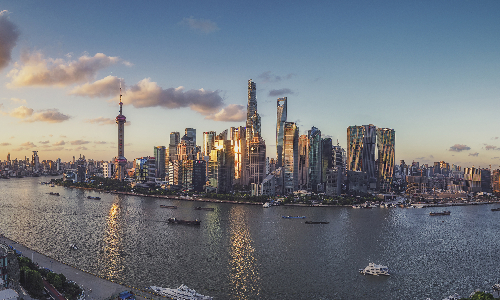
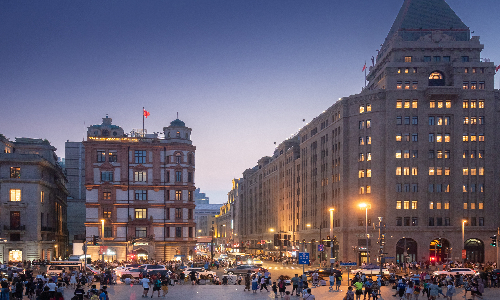
Your 18 days China tour will come to an end. Your tour guide will take you to the airport for your flight home. We hope you had pleasant days in China and look forward to seeing you again in China.
Editor: Summer Hou
Proofreader: Betsy He
| City | Five Star hotel list | Four Star hotel list |
|---|---|---|
| Beijing | Sunworld Dynasty Hotel Beijing Wangfujing | Sunworld Hotel Wangfujing |
| Xi'an | Tianyu Gloria Grand Hotel Xi'an | Sunworld Dynasty Hotel |
| Chengdu | Sofitel Chengdu Taihe | Holiday Inn Express Chengdu Jinniu |
| Guilin | Lijiang Waterfall Hotel | Guilin Bravo Hotel |
| Lijiang | Wonderport International Hotel | Lijiang Wangfu Hotel |
| Shaxi | Sunyata Hotel | Wuliu Xinsu Hotel |
| Dali | The One Hotels & Resorts | Landscape Hotel |
| Shanghai | Ocean Hotel Shanghai | Courtyard by Marriott Shanghai Central |
 |
![]() About your child or infant, please contact us for a discounted price.
About your child or infant, please contact us for a discounted price.



We started with a few days in Beijing & ended in Shanghai, from where we visited the Forbidden City and Great Wall. In between we visited Terra Cotta Warriors Museum, Panda Base, Shanghai Disneyland.

We had a wonderful holiday in China which will remain long in the memory. China is a breathtakingly beautiful country full of splendid temples and palaces, mountains and rivers, peaceful rural scenes and bustling shopping streets.
 QUICK ENQUIRY
QUICK ENQUIRY